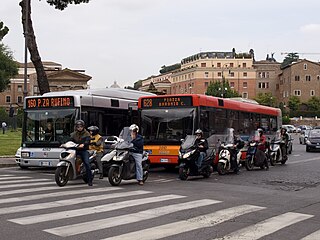
The Rome Metro is a rapid transit system that operates in Rome, Italy. It started operation in 1955, making it the oldest in the country.

Monti is the 1st rione of Rome, Italy, identified by the initials R. I, located in Municipio I. The name literally means 'mountains' in Italian and comes from the fact that the Esquiline, the Viminal Hills, and parts of the Quirinal and the Caelian Hills belonged to this rione: currently, however, the Esquiline Hill belongs to the rione Esquilino.

Campitelli is the 10th rione of Rome, Italy, identified by the initials R. X, and is located in the Municipio I.

Spagna is an underground station on Line A of the Rome Metro, in the rione Campo Marzio, which was inaugurated in 1980.

Barberini–Fontana di Trevi is an underground station on Line A of the Rome Metro, inaugurated in 1980 and situated under Piazza Barberini in Trevi. Originally, the station was simply named Barberini, and the name was extended in 2000.

Vittorio Emanuele is a station on Line A of the Rome Metro. The station was inaugurated in 1980 and is sited underground, beneath Piazza Vittorio Emanuele II, which gives it its name, in the Esquilino rione.

Line C is a Rome Metro line which runs from Monte Compatri-Pantano in the eastern suburbs of Rome, in Italy, to San Giovanni near the city centre, where it meets Line A. It is the third metro line to be built in the city and the first to be fully automated.

Cavour is a station on Line B of the Rome Metro, opened on 10 February 1955. It is located on via Cavour, in the Monti rione of Rome, midway between Santa Maria Maggiore and via dei Fori Imperiali.

Piramide is a station on Line B of the Rome Metro. It was opened on 10 February 1955 and is sited on Piazzale Ostiense just outside Porta San Paolo, in the Ostiense quarter. Its atrium houses mosaics that have won the Artemetro Roma by Enrico Castellani (Italy) and Beverly Pepper. The station has escalators.

EUR Magliana is a railway station in Rome served by the Metro line B and the Ferrovia Roma-Lido in the EUR or Europa district of Rome. It was opened in 1924 as a Roma-Lido station for the Esposizione Universale Roma as Magliana. It was later renamed Magliana Ostiense, then Magliana again and finally its present name.

EUR Fermi is a station on Line B of the Rome Metro. Opened in 1955, it is sited in the EUR between Viale America and Piazza della Stazione Enrico Fermi. Next to it is the artificial lake created for the 1960 Summer Olympics. The station's atrium houses mosaics which have won the Artemetro Roma prize by Bruno Ceccobelli (Italy) and Rupprecht Geiger (Germany).

The Rome tramway network composed of 6 tram lines operating in the city of Rome, Italy, part of the Rome’s public transport network. The current tram system in Rome, is a leftover from what once was the largest tram system in Italy. The system is owned and operated by Azienda Tranvie e Autobus del Comune di Roma.
Rome is a tourist destination of archaeological and artistic significance. Among the most significant resources are museums – —aqueducts, fountains, churches, palaces, historical buildings, the monuments and ruins of the Roman Forum, and the Catacombs. Rome is the 2nd most visited city in the EU, after Paris, and receives an average of 7–10 million tourists a year, which sometimes doubles on holy years. The Colosseum and the Vatican Museums are the 39th and 37th (respectively) most visited places in the world, according to a 2009 study. In 2005 the city registered 19.5 million of global visitors, up of 22.1% from 2001. In 2006, Rome was visited by 6.03 million international tourists, reaching 8th place in the ranking of the world's 150 most visited cities. The city has also been nominated 2007's fourth most desirable city to visit in the world, according to lifestyle magazine Travel + Leisure, after Florence, Buenos Aires and Bangkok. Rome is the city with the most monuments in the world.

Rome has an extensive internal transport system and is one of the most important road, rail and air hubs in Italy.

Venezia is a metro station under construction on Line C of the Rome Metro system in Piazza Venezia, in the heart of the city. Construction works started on 22 June 2023.

San Giovanni is an underground interchange station on Lines A and C of the Rome Metro.

ATAC S.p.A. is an Italian publicly owned company running most of the local public transportation services, paid parking and incentive parking lots in Rome. More specifically, the company handles, on behalf of Roma Capitale Authority, the entire tramway, trolleybus network and metro lines, as well as most of the bus lines in the city. It also operates, on behalf of the Administrative Region of Lazio, three railways: Roma-Civita Castellana-Viterbo, Roma-Giardinetti and Roma-Lido. ATAC S.p.A., with its 2,200-kilometer-wide public transport network, its over 8,500 busses and 70,000 parking stalls, is currently one of the biggest public transportation companies in Europe and the largest in Italy.

The Piazza Euclide railway station is a railway station in Rome (Italy), on the Rome–Civitacastellana–Viterbo railway, managed by ATAC. It is the only underground stop of the line, excluding the Flaminio terminus.





















